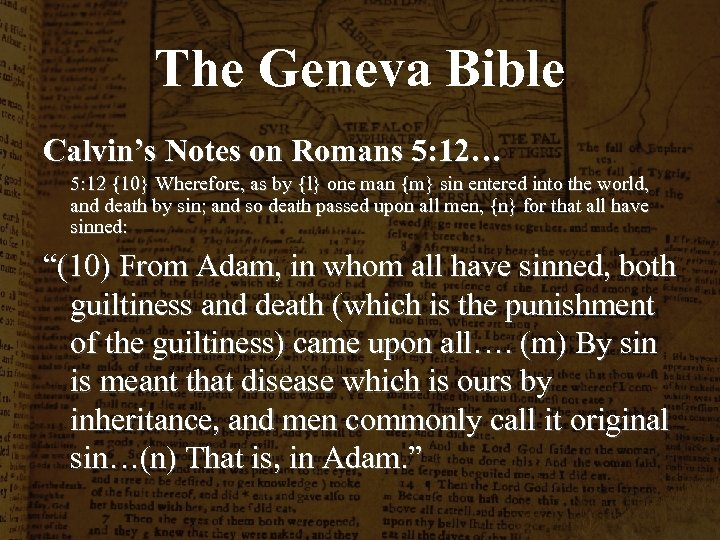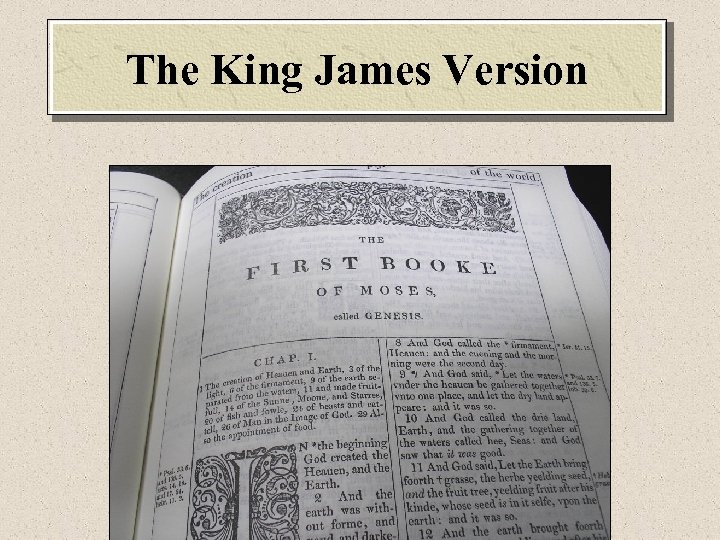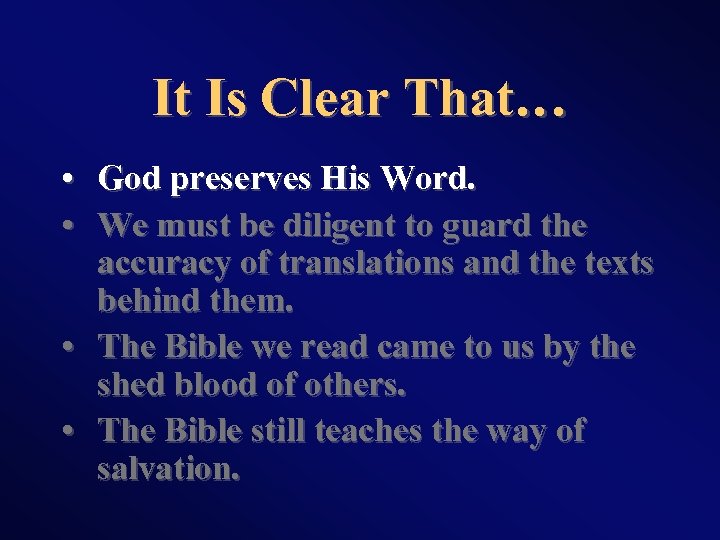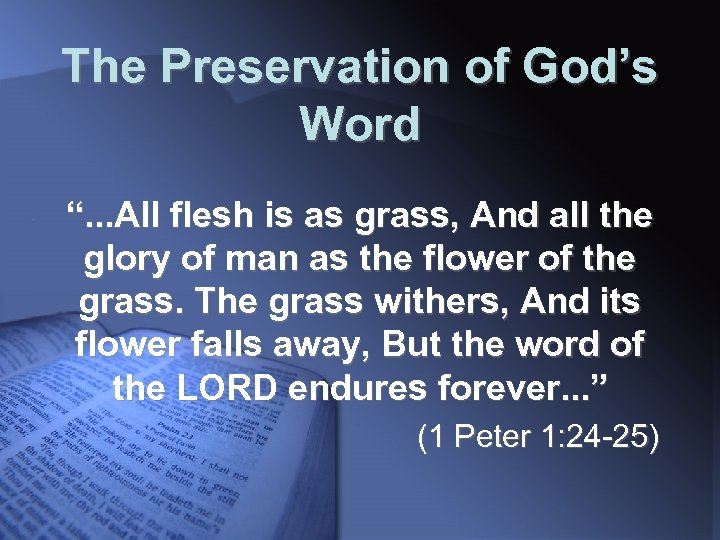c31de8f19b979adf96a962e7cb2c8c92.ppt
- Количество слайдов: 114


How Did We Get the Bible?

How We Got the Bible Lesson Three: The History of the English Bible

Am I A Soldier of the Cross? Isaac Watts 1724 “…Must I be carried to the skies on flow’ry beds of ease, while others fought to win the prize and sailed through bloody seas? . . . ”

Translation of the New Testament

The Translation of the Bible Syriac 200 s

Early Translations: Syriac In the 2 nd & 3 rd centuries the Bible was translated into Syriac, a dialect of Aramaic used in the region of Antioch. • The most widely accepted version was called the Peshitta, meaning “Pure. ” •

The Translation of the Bible Syriac 200 s Coptic 200 s

Early Translations: Coptic In the 2 nd & 3 rd centuries the Bible was translated into Coptic, the form of Egyptian in use at the time. • The Greek alphabet was adopted with a few added letters, under the influence of Bible translators. •

The Translation of the Bible Gothic 300 s Syriac 200 s Coptic 200 s

Early Translations: Gothic About 350 Wulfilas, began to translate portions of the Bible into the Gothic language of the Goths of Dacia. • Wulfilas had to invent an alphabet for Gothic in order to even make a translation. •

The Translation of the Bible Latin 200 s Gothic 300 s Syriac 200 s Coptic 200 s

Early Translations: Old Latin • In the 2 nd & 3 rd centuries the Bible was translated into Latin, rapidly growing to be the language of the Roman empire.

The Translation of the Bible Latin 200 s Armenian 400 s Gothic 300 s Syriac 200 s Coptic 200 s

Early Translations: Armenian In the 5 th century Mesrop invented alphabets for Aremenian & Georgian in order to translate the Bible into these languages. • These alphabets are still in use. •

The Translation of the Bible Latin 200 s Armenian 400 s Gothic 300 s Syriac 200 s Coptic 200 s Ethiopic 500 s

Early Translations: Ethiopic In the 4 th century the New Testament was translated into Ethiopic (or Ge’ez). • Jews had been in Ethiopia for some time. • The Old Testament was translated into Ethiopic well before this. •

The Translation of the Bible Slavonic 800 s Latin 200 s Armenian 400 s Gothic 300 s Syriac 200 s Coptic 200 s Ethiopic 500 s

Early Translations: Slavonic In the 800 s Cyril & Methodius, two brothers, taught among the Slavs. • To translate the Bible they too had to invent an alphabet for their language, now called “Old Church Slavonic. ” • Russian is written in the Cyrillic alphabet. •

“Into All the World” “And He said to them, ‘Go into all the world and preach the gospel to every creature. He who believes and is baptized will be saved; but he who does not believe will be condemned. ” (Mark 16: 15, 16)

“How Shall They Hear? ” “How shall they call on Him in whom they have not believed? And how shall they believe in Him of whom they have not heard? And how shall they hear without a preacher? (Romans 10: 14)

The Teaching of Ezra “So they read distinctly from the book of the Law of God; and they gave the sense, and helped them understand. ” (Nehemiah 8: 8)

Jesus Was Proclaimed Without cell phones. • Without the internet. • Without computers. • Without printing presses. • Without airplanes. • Without automobiles. •

The Latin Vulgate

Jerome (ca. 342 -420) § Trained as a boy in Greek & Latin classics and grammar. § Studied Hebrew in a cave for some time. § Found the Latin Bible texts of his day coarse.

Jerome (ca. 342 -420) § In Constantinople, served as the secretary to pope Damasus. § Damasus assigned him to work on a new Latin translation.

Jerome (ca. 342 -420) Commenting on the confusing state of Old Latin Bible texts of his day, he once said… “There almost as many forms of the text as there are copies. ”

Jerome (ca. 342 -420) Commenting on Old Testament apocryphal texts said they were like… “The crazy wanderings of a man whose senses have taken leave of him. ” Did not believe they were canonical.

Jerome (ca. 342 -420) § Traveling to Palestine and comparing different manuscripts, Jerome (with others) prepared the first critical Latin translation of the Bible in 405.

The Latin Vulgate § Was written in Vulgar (i. e. “Common”) Latin, for the common man. § The Vulgate came to be viewed as the official “authorized version” of Western Europe for 1000 years.

C The Latin Vulgate… • Was a translation. (The original Biblical texts were in Hebrew & Latin). • Was intended for the common man. • Represented excellent scholarship, but was not flawless.

C The Latin Vulgate… • Was a translation. (The original Biblical texts were in Hebrew & Latin). • Was intended for the common man. • Represented excellent scholarship, but was not flawless.

C The Latin Vulgate… • Was a translation. (The original Biblical texts were in Hebrew & Latin). • Was intended for the common man. • Represented excellent scholarship, but was not flawless.

“Test All Things” “Test all things; hold fast what is good. ” (1 Thessalonians 5: 21)

The Possibility of Apostasy “For the time will come when they will not endure sound doctrine, but according to their own desires because they have itching ears…”

The Possibility of Apostasy “…they will heap up for themselves teachers and they will turn their ears away from the truth and be turned aside to fables. ” (1 Timothy 4: 3, 4)

It is Right To… Make certain that copies of texts are accurate n Make certain that translations are accurate n This does not reflect a lack of trust in God or the inspiration of Scripture n In the days of Josiah the “Book of the Law” was lost!

The Middle Ages

The Bible in the Middle Ages • Only the wealthy could afford Bibles.

The Bible in the Middle Ages • All copies were made by a scribe, by hand.

The Bible in the Middle Ages • The common man was not encouraged to read the Bible.

The Bible in the Middle Ages • Bibles were so expensive they were chained to pulpits. • Roman Catholic church dominated Western Europe.

The Bible in the Middle Ages • The first Bible Luther ever saw was chained to a library wall. • The Bible in many ways was chained.

The Bible in the Middle Ages • Preaching was in Latin even when it was no longer spoken. • Latin had become the language of Europe’s scholars.

The Bible in the Middle Ages • The Latin Vulgate was the only Bible accepted by the Catholic church in Western Europe.

The Bible in the Middle Ages • The common people were ignorant of God’s word.

The Bible in the Middle Ages This was rightly called the “Dark Ages”

Lack of Knowledge “My people are destroyed for lack of knowledge. Because you have rejected knowledge, I also will reject you from being priest for Me; Because you have forgotten the law of your God, I also will forget your children. ” (Hosea 4: 6)

Shutting Off the Word “But woe to you, scribes and Pharisees, hypocrites! For you shut up the kingdom of heaven against men; for you neither go in yourselves, nor do you allow those who are entering to go in. ” (Matthew 23: 13)

The Renaissance & the Reformation

Three Things That Changed History • The Printing Press • Christian Humanism. • The Protestant Reformation

Three Things That Changed History • The Printing Press • Christian Humanism. • The Protestant Reformation

Three Things That Changed History • The Printing Press • Christian Humanism. • The Protestant Reformation

Papermaking • Although papermaking was invented in China in 105 AD, it did not make its way to Europe until 950. • The first paper mill in Europe was set up Spain in 1150. • This made book making easier and cheaper.

The Printing Press • In 1452 Johannes Gutenberg succeeded in operating the first printing press with moveable type. • The first printed publication was a papal indulgence – granting forgiveness of sins to the bearer.

The “ 42 Line” Bible • In 1457 Gutenberg began printing the socalled “ 42 Line” Bible. A printed edition of the Latin Vulgate named for its 42 lines per page. • Typesetters took an entire day to layout one page of text.

“Christian” Humanism • From the 14 th -16 th centuries a move spread across Europe known as Humanism. • Unlike modern humanism which sees man as the sum of all things, “Christian” humanism, fostered an appreciation for what man could do with the abilities God had given them. • This movement led to an appreciation of classical learning (and texts) with a strong desire to look back to original sources.

Desiderius Erasmus • In 1504 Erasmus read a work by Lorenzo Valla entitled Annotations on the New Testament. • Valla sought to look back to the original language of Scripture to overcome false concepts that had arisen over time.

Desiderius Erasmus • Erasmus was intrigued and set himself to the task of comparing manuscripts of the Greek New Testament to analyze the text. • In 1516 Erasmus published the first critical edition of the Greek NT with the Vulgate in a parallel column. In 1518 he replaced the Vulgate with his own translation.

Desiderius Erasmus 1469 -1536 In the preface to his 1516 edition of the Greek New Testament says… “I wish that the Scriptures might be translated into all languages so that not only the Scot and the Irish, but also the Turk and the Saracen might read and understand them…”

Desiderius Erasmus 1469 -1536 “…Then I long that the farmlaborer might sing them as he follows the plough, the weaver hum them to tune of his shuttle, the traveler beguile the weariness of the journey with their stories. ”

Robert Stephanus • In 1550 Robert Estienne (Lat. Stephanus) published a revision in Geneva of Erasmus’ text making use of more manuscripts. • Stephanus setup the chapter and verse divisions in use today. • Stephanus’ work came to be known as the “Text received by all” or Textus Receptus.

The Protestant Reformation • In 1517 a German monk named Martin Luther challenged the Catholic church’s practice of selling indulgences. • Although originally interested in only reforming Catholicism, Luther’s ideas spawned a movement throughout Europe which rejected the authority of Rome.

Luther’s Bible • A motto of this reformation was sola scriptura “the Scriptures alone. ” • In 1522, using Erasmus’ Greek NT Luther made the first translation of the NT in German from the original Greek. • This became the Bible of many Protestants and fueled the desire of other reformers to possess the Bible in their own tongue.

Martin Luther 1483 -1546 Commenting on the Bible, said… “No clearer Book has been written in this wide world than the Holy Scriptures. Compared with all other books it is like the sun over all other lights…”

Martin Luther 1483 -1546 “…Don't let them lead you out of and away from it, much as they may try to do so. For if you step out, you are lost; they take you wherever they wish. If you remain within, you will be victorious. ”

The Bible is Sufficient “All Scripture is given by inspiration of God, and is profitable for doctrine, for reproof, for correction, for instruction in righteousness, that the man of God may be complete, thoroughly equipped for every good work. ” (2 Timothy 3: 16, 17)

The Bible is Sufficient “…From childhood you have known the Holy Scriptures, which are able to make you wise unto salvation through faith which is in Christ Jesus” (2 Timothy 3: 15)

Man Needs No… Priest to interpret them n Council to define them n Additional revelation to understand them n Great Intellect to comprehend them n God knows how to Speak!

Understanding Through Reading “…When you read, you may understand my knowledge in the mystery of Christ. ” (Ephesians 3: 4)

The Bible into English

Beginnings of an English Bible • In 735 Aldhelm & Bede translated the gospel of John into Anglo-Saxon, an ancient form of English. • In the 800 s King Alfred distributed Exodus, Psalms and Acts to the people in Anglo-Saxon. • No manuscripts of these works have survived.

The Lindisfarne Gospels • In 950 a priest named Aldred wrote Anglo. Saxon translations above the Latin text of an older manuscript of the gospels originally produced at Lindisfarne.

The Wycliffe Bible • John Wycliffe, led a group of priests who believed that preaching should be done in the language of the people, not Latin. These were later called sarcastically Lollards – meaning “mutterers. ” He died in 1384.

The Wycliffe Bible In 1395 one of Wycliffe’s followers John Purvey, published the first entire translation of the Bible into English from the Latin. In 1408 it was outlawed. • In 1428, Pope Martin V ordered Wycliffe’s body exhumed, burned and the ashes scattered on a stream near his house. •

The British Throne 1500 1525 1550 Henry VIII 1509 -1547 Edward VI 1547 -1553 Mary I 1553 -1558 Elizabeth I 1558 -1603 1575 1600 1625 James I 1603 -1625 Tyndale 1526

The Tyndale Bible • William Tyndale came to Cambridge shortly after Erasmus left. • He was very interested in Erasmus’ writings and became skilled in Greek.

The Tyndale Bible • In response to laws forbidding the translation of the Bible into English, William Tyndale went to Germany, where he translated the New Testament into English from the Greek.

William Tyndale 1494 -1536 To a one who was critical of his plan to translate the Bible into English – “If God spare my life, ere many years pass, I will cause a boy that driveth the plough shall know more of Scriptures than thou dost. ”

The Tyndale Bible • Tyndale’s New Testament was published in 1526 and smuggled into England. Officials burned all copies they could find. In 1536 he was arrested, strangled and burned at the stake. • His dying words were, “Lord, open the King of England’s eyes!” •

The Tyndale Bible • The Tyndale Bible introduced many words into English for which he could find no existing word (e. g long-suffering). • The Tyndale Bible was more literal in some passages than some versions which followed it.

The Tyndale Bible “But and yf I tarie longe, that then thou mayst yet have knowledge how thou oughtest to behave thyselfe in the housse of God, which is the congregacion of the livinge God, the pillar and grounde of trueth” (1 Timothy 3: 15)

The British Throne 1500 1525 1550 Henry VIII 1509 -1547 Edward VI 1547 -1553 Mary I 1553 -1558 Elizabeth I 1558 -1603 1575 1600 1625 James I 1603 -1625 Tyndale 1526 Coverdale Matthew’s 1535 1537

The Coverdale Bible • Miles Coverdale, also worked in Germany with Tyndale and supported Luther’s reforms. • In 1535 he published a complete translation of the entire Bible into English. • He used Latin & German texts for the Old Testament.

The Matthew’s Bible • In 1537 another friend of Tyndale, John Rogers, published another complete Bible, making use of some of Tyndale’s unpublished notes. • Rogers gave credit for the work to Thomas Matthew, but he is believed to have done most of the translation.

The British Throne 1500 1525 1550 Henry VIII 1509 -1547 Edward VI 1547 -1553 Mary I 1553 -1558 Elizabeth I 1558 -1603 1575 1600 1625 James I 1603 -1625 Tyndale 1526 Coverdale Matthew’s 1535 1537 Great Bible 1539

The Great Bible • In 1537 Coverdale was commissioned by Thomas Cromwell, the chancellor of England to revise the Matthew’s Bible. • The “Great Bible” was published in 1539 with the sanction of Henry VIII and used Hebrew texts for the Old Testament.

Cromwell & Cranmer • Thomas Cromwell, Henry VIII’s chancellor, did a great deal to move the crown towards allowing an English Bible. • He is pictured to the right of the King on the title page of the Great Bible. • In 1540 he was executed by Henry VIII.

Cromwell & Cranmer • Thomas Cranmer, was Archbishop of Canterbury during the reign of Henry VIII. He also did a great deal to move the crown towards allowing an English Bible. • He is pictured to the left of the King on the title page of the Great Bible. • In 1556 he was burned at the stake by the Catholic Mary I.

The Great Bible Cranmer Cromwell

The Council of Trent • In response to the rise of Protestantism a Council of Catholic theologians declared on April 8, 1546 that the Vulgate was the sole authoritative text in matters of faith & morals.

The Clementine Vulgate • The council did acknowledge that the Vulgate was not without its imperfections and called for new revisions and corrections. • The final revision of Pope Clement VIII, in 1592, is the “Clementine Vulgate. ”

Mary I - “Bloody Mary” • A strict Catholic, Mary Tudor persecuted Puritans and other Protestants. • Public reading of the Bible in English was outlawed. • Thomas Cranmer & John Rogers, the translator of the Matthews Bible, were burned at the stake. • Miles Coverdale, barely escaped from her alive.

The British Throne 1500 1525 1550 Henry VIII 1509 -1547 Edward VI 1547 -1553 Mary I 1553 -1558 Elizabeth I 1558 -1603 1575 1600 1625 Tyndale 1526 James I 1603 -1625 Geneva 1560 Coverdale Matthew’s 1535 1537 Great Bible 1539

The Geneva Bible • When Mary I came to the throne in 1553 and sought to reaffirm Catholicism in England, persecuted Puritans fled to Geneva. • There in 1557, William Whittingham, John Calvin’s brother-inlaw, produced a revision of the Great Bible including Calvin’s notes in the margins.

The Geneva Bible This was the Bible the “Pilgrim’s” used.

The Geneva Bible Calvin’s Notes on Romans 5: 12… 5: 12 {10} Wherefore, as by {l} one man {m} sin entered into the world, and death by sin; and so death passed upon all men, {n} for that all have sinned: “(10) From Adam, in whom all have sinned, both guiltiness and death (which is the punishment of the guiltiness) came upon all…. (m) By sin is meant that disease which is ours by inheritance, and men commonly call it original sin…(n) That is, in Adam. ”

The British Throne 1500 1525 1550 Henry VIII 1509 -1547 Edward VI 1547 -1553 Mary I 1553 -1558 Elizabeth I 1558 -1603 1575 1600 1625 Tyndale 1526 Coverdale Matthew’s 1535 1537 James I 1603 -1625 Geneva 1560 Bishops’ 1535 Rheims. Douay 1582 Great Bible 1539

The Bishops’ Bible • In 1568 Elizabeth I, unhappy with the Calvinistic notes in the Geneva Bible, assigned Matthew Parker to revise the Great Bible. • Parker worked with eight Bishops and produced the “Bishops’ Bible, ” to be placed in every church.

Rheims-Douay Bible • By the late 1500 s, Rome finally accepted that an English Bible inevitable. • In 1582 Gregory Martin published a New Testament for Catholics from the Latin Vulgate in Rheims. • The Old Testament was published in 1609 from Douay.

The British Throne 1500 1525 1550 Henry VIII 1509 -1547 Tyndale 1526 Edward VI 1547 -1553 Mary I 1553 -1558 Elizabeth I 1558 -1603 Geneva 1560 1575 1600 1625 Coverdale Matthew’s 1535 1537 James I 1603 -1625 King James 1611 Bishops’ 1535 Rheims. Douay 1582 Great Bible 1539

The King James Version • King James I, in line with an agreement he had made with Puritan leaders, assigned 54 scholars to create an “Authorized Version. ” • Scholars from Oxford, Cambridge & Westminster worked in 6 groups, who compared and checked one another.

The King James Version • In 1611 (after 7 years), it was published being the first English version with no doctrinal notes. • It is estimated to follow 80 -90% of Tyndale’s text. • In 1873 the Church of England issued a revision which is what is called today the “King James Version. ”

The King James Version

The Look Changes… “Peter sayde unto them: repent and be baptised every one of you in the name of Jesus Christ for the remission of synnes…” Tyndale Bible - 1535 (Acts 2: 38) “Peter sayde unto them: repent of youre synnes, and be baptysed every one of you in the name of Jesus Christ for the remission of synnes…” Great Bible – 1540 (Acts 2: 38)

The Look Changes… “Then Peter sayd unto them, Amende your lyves, and be baptized everie one of you in the Name of Jesus Christ for the remission of sinnes…” Geneva Bible – 1562 (Acts 2: 38) “Then Peter sayd unto them, Repent ye, and let every one of you be baptized in the name of Jesus Christ for the remission of sinnes…” Bishops’ Bible - 1602 (Acts 2: 38)

The Meaning Remains the Same “Then Peter said unto them, Repent, and be baptized every one of you in the name of Jesus Christ for the remission of sins…” King James Version (Acts 2: 38)

It Is Clear That… • God preserves His Word. • We must be diligent to guard the accuracy of translations and the texts behind them. • The Bible we read came to us by the shed blood of others. • The Bible still teaches the way of salvation.

The Preservation of God’s Word “For assuredly, I say to you, till heaven and earth pass away, one jot or one tittle will by no means pass from the law till all is fulfilled. ” (Matthew 5: 18)

The Preservation of God’s Word “. . . All flesh is as grass, And all the glory of man as the flower of the grass. The grass withers, And its flower falls away, But the word of the LORD endures forever. . . ” (1 Peter 1: 24 -25)

It Is Clear That… • God preserves His Word. • We must be diligent to guard the accuracy of translations and the texts behind them. • The Bible we read came to us by the shed blood of others. • The Bible still teaches the way of salvation.

It Is Clear That… • God preserves His Word. • We must be diligent to guard the accuracy of translations and the texts behind them. • The Bible we read came to us by the shed blood of others. • The Bible still teaches the way of salvation.

It Is Clear That… • God preserves His Word. • We must be diligent to guard the accuracy of translations and the texts behind them. • The Bible we read came to us by the shed blood of others. • The Bible still teaches the way of salvation.

c31de8f19b979adf96a962e7cb2c8c92.ppt